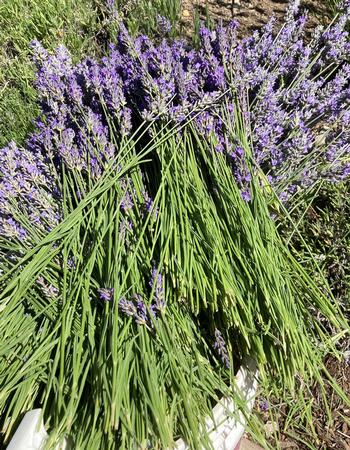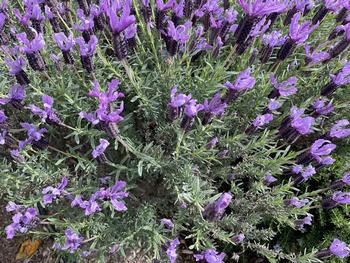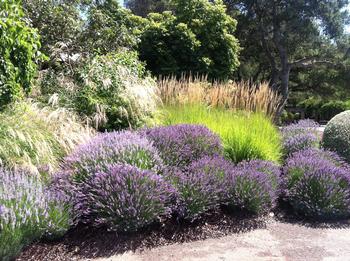Sun shining on lavender
-
Anne-Marie Walker
-
Unfurling a brilliance of unusual flower spikes, lavender graces our gardens in shades ranging from blue, white, pink, deep purple, red to pale lavender. If your lavender plants show signs of rot, the best time to plant lavender in Marin is from April to May or fall. An evergreen perennial, lavender is a dry-climate plant belonging to the mint family that grows beautifully when the conditions of its native habitat are honored. Native to the Mediterranean, it is one of the most common plants found in the garrigue, the area’s lower-growing vegetation. Lavender does not like soggy sites. Adding lava rock or pumice to your soil improves aeration. Planting mounds can channel water away from the lavender’s root crown.
 The harvest of 'Provence’ lavender at about 50% blooming. Photo: Alice Cason
The harvest of 'Provence’ lavender at about 50% blooming. Photo: Alice CasonThose who grow lavender follow these basics: full sun for at least 6 hours, no overhead sprinklers, quick-to-drain soil, no fertilizer or compost, little to no water in summer, and a clipping every autumn. With so many varieties of lavenders, each tolerating different ranges of temperature and drought resistance, it’s important to select the right lavender for your garden. The genus Lavandula is divided into three sections: Spica, Stoechas, and Pterostoechas. Sometimes the nomenclature of lavenders can be confusing, and invalid names frequently pop up in nurseries. The correct names all describe leaf shape.
English lavender, known synonymously as L. angustifolia, L. latifolia, L. officinalis, and L. spica, belongs to the Spica section. These lavenders grow to two feet, have excellent flower scent, and tolerate temperatures to 15 degrees F. English lavender is a popular choice for gardens and produces the best oil. ‘Hidcote,’ ‘Munstead,’ and ‘Martha Roderick’ remain favorites. Hybrids of L. angustifolia (Latin for narrow leaf) and L. latifolia (Latin for broad leaf) are called Lavandins and are usually labeled “L. X intermedia.” These bloom later than English lavenders and produce flowers on taller stems, but dried blooms do not retain color. Some favorite lavandins in my Marin garden include ‘Grosso’ with purple flowers good in sachets and flower wands, and ‘Provence,’ its blue flowers good in herbal teas, cookies, and lemonade.
Another species that brings beauty to our gardens is Lavandula dentata, also known as French lavender, from the Stoechas section. Native to Spain, Greece, North Africa, and the Canary Islands, French lavender has proven a vigorous grower in Marin. Blooming from late winter through fall, its leaf margins look like tiny teeth, and blooms are blue on long stalks 6 to 8 inches above the foliage. One variety, L. d. var. candicans, is good as a hedge with a wider growth habit, often to 5 feet. Its leaves are gray, and its flowers are lavender. Spanish lavender and Italian lavender also belong in the Stoechas section. They thrive in warm and dry areas and are the showiest of lavenders. L. s.‘Otto Quast’ produces an intensely purple bloom, and L. s. ‘Alba’ pure white flowers. Both are great choices in massed groupings in mixed perennial gardens. They grow 2 to 3 feet tall and wide, tolerate temperatures to 15 degrees F, and are UC Davis Arboretum All-Star Plants. Pterostoechas lavenders grow in the wild in Morocco and Asia. Sun Shining on Spanish Lavender. Photo: Anne-Marie WalkerWhen plant size and length of bloom season enter the selection process, remember English lavenders are generally shorter, and French lavenders bloom for many months longer. The Lavandins form spiky balls, evoking a look treasured by many a gardener, and Spanish lavenders produce the showiest blooms. All lavender blooms attract a large number of buzzing bees and busy pollinators. Lavender bloom is best viewed at several local lavender farms from May through July. It’s an experience you don’t want to miss. Some allow “ u harvest,” so you can bring home your lavender, tie it into bundles of 7 stems and hang it upside down in dry, low-light conditions for about two weeks—happy dreams of the sun shining on lavender.
Sun Shining on Spanish Lavender. Photo: Anne-Marie WalkerWhen plant size and length of bloom season enter the selection process, remember English lavenders are generally shorter, and French lavenders bloom for many months longer. The Lavandins form spiky balls, evoking a look treasured by many a gardener, and Spanish lavenders produce the showiest blooms. All lavender blooms attract a large number of buzzing bees and busy pollinators. Lavender bloom is best viewed at several local lavender farms from May through July. It’s an experience you don’t want to miss. Some allow “ u harvest,” so you can bring home your lavender, tie it into bundles of 7 stems and hang it upside down in dry, low-light conditions for about two weeks—happy dreams of the sun shining on lavender. The spiky balls of Lavandins punctuate a mixed border at a local winery. Photo: Alice Cason
The spiky balls of Lavandins punctuate a mixed border at a local winery. Photo: Alice Cason



